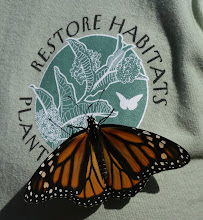 Today we returned to the Ellwood Main site armed with maps and GPS coordinates of the aggregation sites in Ellwood North, West and Central. While we didn't find any blue tagged monarchs, we were relieved to see more activity. Altogether we saw 156 monarch flyers in the area during the 90 minutes we were walking the area. The monarchs were active and moving about, often stopping to sip the morning dew. We saw the largest number of monarchs in the Sandpiper Golf Course area of the preserve. While the number of flyers made it harder to search for blue tags than if they were clustering, it was comforting to know the monarchs numbers are larger than we originally thought.
Today we returned to the Ellwood Main site armed with maps and GPS coordinates of the aggregation sites in Ellwood North, West and Central. While we didn't find any blue tagged monarchs, we were relieved to see more activity. Altogether we saw 156 monarch flyers in the area during the 90 minutes we were walking the area. The monarchs were active and moving about, often stopping to sip the morning dew. We saw the largest number of monarchs in the Sandpiper Golf Course area of the preserve. While the number of flyers made it harder to search for blue tags than if they were clustering, it was comforting to know the monarchs numbers are larger than we originally thought.We knew we had a long drive ahead of us so we began our trip North. As we were d
 riving on Hwy 101 we saw a monarch flying East to West 7 miles West of Gaviota around noon. Then two minutes later we spotted another monarch 1/2 mile South of exit 128 followed by seeing two more monarchs flying again East to West at exit 128. By 12:05 another monarch sped by near the Gaviota sign. We stopped at the "Gaviota Rest Area" at 12:14 when the sixth monarch sped by. Amazing sight! We were both surprised to see so much activity in such a narrow time-frame. We saw the last flying monarch of the day at 2PM on Hwy 1, 2.5 miles South of Oceana. Again the flight had an East to West trajectory at a good clip.
riving on Hwy 101 we saw a monarch flying East to West 7 miles West of Gaviota around noon. Then two minutes later we spotted another monarch 1/2 mile South of exit 128 followed by seeing two more monarchs flying again East to West at exit 128. By 12:05 another monarch sped by near the Gaviota sign. We stopped at the "Gaviota Rest Area" at 12:14 when the sixth monarch sped by. Amazing sight! We were both surprised to see so much activity in such a narrow time-frame. We saw the last flying monarch of the day at 2PM on Hwy 1, 2.5 miles South of Oceana. Again the flight had an East to West trajectory at a good clip.We stopped at Oceana Campground, the site of just over 10,000 monarchs back in 2002. The annual count last week noted zero monarchs this year. Bob and I also found this to be true. So we drove up the
 road to the North Beach Campground at Pismo Beach. Pismo is heralded as one of the largest monarch sanctuaries of the area with a high of 100,000 monarchs in 1997 that dropped over the decade to 23,050 in 2008. This year's count was only 6,711 monarchs, a significant decline and a reflection of the lower numbers seen up and down the coast this winter. Despite temperatures of 60 degrees, a few monarchs were fluttering about, but most were in dense but small clusters. A few small telescopes were set up to see the monarchs up close and docents were available for information. No blue tags here that we could see. Interestingly they still have the old migration maps up that shows no monarch activity in Arizona with an arrow over the top part of our state going to California. Given Chris Kline's results with the Southwest Monarch Study we know this isn't the case. But change is slow. Sometimes, so is openness to change.
road to the North Beach Campground at Pismo Beach. Pismo is heralded as one of the largest monarch sanctuaries of the area with a high of 100,000 monarchs in 1997 that dropped over the decade to 23,050 in 2008. This year's count was only 6,711 monarchs, a significant decline and a reflection of the lower numbers seen up and down the coast this winter. Despite temperatures of 60 degrees, a few monarchs were fluttering about, but most were in dense but small clusters. A few small telescopes were set up to see the monarchs up close and docents were available for information. No blue tags here that we could see. Interestingly they still have the old migration maps up that shows no monarch activity in Arizona with an arrow over the top part of our state going to California. Given Chris Kline's results with the Southwest Monarch Study we know this isn't the case. But change is slow. Sometimes, so is openness to change.



